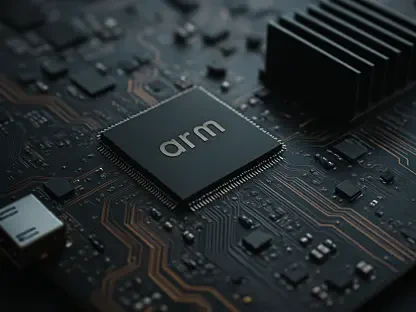In an era where the Internet of Things (IoT) is transforming industries at an unprecedented pace, the challenge of managing diverse communication protocols across regions and applications remains a significant hurdle for manufacturers and utilities alike, often leading to increased costs and operational inefficiencies. Semtech Corporation, a key player in high-performance semiconductors and IoT solutions, has stepped forward with a groundbreaking answer to this persistent issue. The introduction of the Unified Software Platform (USP) for LoRa Plus™ devices marks a pivotal moment for multi-protocol IoT deployments. This innovative platform, built as a successor to the LoRa Basics™ Modem, harnesses fourth-generation LoRa® technology to unify a variety of protocols on a single hardware unit. By addressing protocol fragmentation, Semtech is paving the way for streamlined operations in smart metering, industrial systems, and smart home applications, setting a new standard for adaptability and efficiency in the IoT landscape.
Advancing IoT Connectivity with Innovative Technology
Breaking Down Protocol Barriers
The core strength of the LoRa USP™ lies in its ability to support multiple communication protocols, including LoRaWAN®, Wireless M-Bus, Wi-SUN FSK, and proprietary systems, all within one hardware platform. This advancement directly tackles a long-standing pain point in the IoT sector: the need for multiple hardware variants to meet diverse regional and technical demands. By enabling dynamic protocol selection, the platform allows manufacturers to reduce inventory complexity through a single Stock Keeping Unit (SKU) approach. This not only lowers manufacturing costs but also simplifies logistics for utilities and vendors. Furthermore, the open-source framework of LoRa USP™ ensures that software investments remain protected across hardware generations, offering a sustainable solution for long-term deployments. With comprehensive evaluation tools and examples provided, the platform accelerates time-to-market by easing certification processes, making it an attractive option for companies aiming to stay competitive in a rapidly evolving market.
Enhancing Flexibility for Diverse Applications
Beyond simplifying hardware management, the LoRa USP™ offers remarkable flexibility for a wide range of IoT applications, from smart metering to industrial monitoring and smart home ecosystems. Utilities can now adapt connectivity solutions to specific deployment environments without the burden of maintaining separate product lines for each protocol. This adaptability enhances network resilience, ensuring reliable performance even in challenging conditions. The platform’s backward compatibility with legacy systems, such as Wireless M-Bus used in walk-by/drive-by Automated Meter Reading (AMR), combined with support for LoRaWAN in Advanced Metering Infrastructure (AMI), makes it a versatile tool for global utility companies. By providing a unified product offering, Semtech reduces operational complexity and boosts deployment success. This focus on interoperability positions the platform as a forward-thinking solution that aligns with the industry’s growing emphasis on seamless integration across diverse technological landscapes.
Market Impact and Industry Relevance
Meeting the Demand for Interoperability
The launch of LoRa USP™ comes at a time when the smart metering market is experiencing significant growth, with projections estimating a value of $108 billion by 2034 and an annual growth rate of 14%, according to industry research. A notable trend within this space is the increasing demand for interoperability and openness, with over 80% of utilities and nearly 70% of meter vendors prioritizing these qualities in their solutions. LoRa USP™ directly addresses this need by offering a cohesive platform that supports both modern and legacy protocols, ensuring compatibility across varied systems. This capability is especially critical for European and global markets where regional frequency variations and legacy requirements have historically complicated deployments. By simplifying these challenges, Semtech enables manufacturers to achieve economies of scale and deliver scalable solutions that meet the evolving expectations of the industry, reinforcing the platform’s relevance in today’s connectivity-driven environment.
Industry Endorsements and Strategic Positioning
Feedback from industry experts highlights the transformative potential of Semtech’s latest offering. Leaders in the field have noted that multi-protocol support on a single platform resolves critical inventory challenges while providing the flexibility to select optimal connectivity options for specific use cases. This sentiment is echoed by Semtech’s own product marketing insights, which emphasize how the platform empowers smart meter manufacturers to maximize returns on software investments through compatibility with any microcontroller unit (MCU) partner. The strategic positioning of LoRa USP™ as a response to protocol fragmentation and regional disparities underscores its importance in driving standardization and efficiency. With planned demonstrations at upcoming industry events, the platform is set to showcase its dual connectivity features and broader IoT offerings, further solidifying Semtech’s role as a leader in facilitating resilient and adaptable IoT ecosystems for utilities and manufacturers worldwide.
Reflecting on a Game-Changing Solution
Looking back, Semtech’s introduction of the Unified Software Platform for LoRa Plus™ devices stood as a defining moment in addressing the complexities of multi-protocol IoT deployments. This innovative solution effectively bridged the gap between diverse communication protocols, reducing costs and enhancing flexibility for industries reliant on smart metering and IoT connectivity. By consolidating support on a single hardware unit, it tackled inventory challenges head-on and supported the industry’s push toward interoperability. Moving forward, stakeholders were encouraged to explore how such unified platforms could be integrated into existing systems to optimize operations. The focus shifted to leveraging comprehensive tools and open-source frameworks to accelerate adoption and ensure future-proof scalability. This development not only met immediate needs but also laid the groundwork for more efficient and adaptable connectivity solutions, promising a lasting impact on how global industries approached the challenges of an increasingly connected world.









